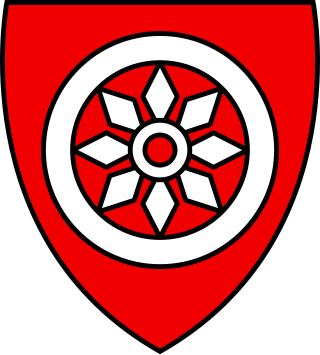Baron Acton, of Aldenham in the County of Shropshire, is a title in the Peerage of the United Kingdom. It was created on 11 December 1869 for Sir John Dalberg-Acton, 8th Baronet, a prominent historian and Liberal Member of Parliament.

The title of Duc de Dalberg was created by the French Emperor Napoleon I on 14 April 1810 for Emmerich von Dalberg, the nephew of Karl Theodor von Dalberg, Prince-Primate of the Confederation of the Rhine and Grand Duke of Frankfurt. He died on 27 April 1833. His daughter, Marie Louise von Dalberg (1813–1860), and heiress married firstly Sir Richard Acton, 7th Baronet and secondly Granville George Leveson-Gower, 2nd Earl Granville, but as the Duke had no sons, the title became extinct.

Karl Theodor Anton Maria von Dalberg was a Catholic German bishop and statesman. In various capacities, he served as Prince-Archbishop of Regensburg, Arch-Chancellor of the Holy Roman Empire, Bishop of Constance and Worms, Prince-Primate of the Confederation of the Rhine and Grand Duke of Frankfurt. Dalberg was the last Archbishop-Elector of Mainz.

The House of Schönborn is the name of an ancient noble and formerly sovereign family of the Holy Roman Empire. As a former ruling and mediatized family, it belongs to the Hochadel.

Friedrich Karl Joseph Reichsfreiherr von Erthal was prince-elector and archbishop of Mainz from 18 July 1774 to 4 July 1802, shortly before the end of the archbishopric in the Reichsdeputationshauptschluss.

The Elector of Mainz was one of the seven Prince-electors of the Holy Roman Empire. As both the Archbishop of Mainz and the ruling prince of the Electorate of Mainz, the Elector of Mainz held a powerful position during the Middle Ages. The Archbishop-Elector was president of the electoral college, archchancellor of the empire, and the Primate of Germany as the papal legate north of the Alps, until the dissolution of the empire in 1806.

Johann von Dalberg (1445–1503) was the Prince-Bishop of Worms from 1482 to 1503.

Sir Ferdinand Richard Edward Dalberg-Acton, 7th Baronet was a British baronet.

The House of Leyen-Hohengeroldseck is an ancient German noble family of princely and historically sovereign rank. As a former ruling and mediatized family, it belongs to the Hochadel.

Wolfgang von Dalberg was the Archbishop-Elector of Mainz from 1582 to 1601.

Wolfgang Heribert Kämmerer von Worms Freiherr von Dalberg was a courtier and statesman of Baden, who served as Minister of State and Grand Master of the Household. He was also the first general administrator of the Mannheim National Theatre.

Johann Adam von Bicken was the Archbishop-Elector of Mainz from 1601 to 1604.

The House of Metternich was an old German noble family originating in the Rhineland. The most prominent member was Prince Klemens von Metternich, who was the dominant figure at the Congress of Vienna (1814–1815). As a former reigning house (mediatised), the Metternich family belonged to the small circle of high nobility.

Emmerich Joseph von Breidbach zu Bürresheim was the Archbishop-Elector of Mainz from 1763 to 1774 and Prince-Bishop of Worms from 1768 to 1774, in which capacities he was notable for introducing reforms inspired by the Enlightenment.

The Philharmonisches Staatsorchester Mainz, is the resident orchestra of the Staatstheater Mainz. In addition to musical theatre and Tanztheater, youth symphony and chamber concerts are part of the activity of the orchestra. It is one of the three state symphony orchestras of Rhineland-Palatinate. Since September 2011, Hermann Bäumer has been principal conductor.

Emmerich Joseph Wolfgang Heribert de Dalberg, 1st Duke of Dalberg was a German diplomat who was elevated to the French nobility in the Napoleonic era and who held senior government positions during the Bourbon Restoration.

The Marquessate of Groppoli, in Tuscany and Liguria, was ruled by the House of Brignole-Sale, an illustrious patrician family of Genoa who were its sovereigns from 1592 to 1774.

Marianne von der Leyen und zu Hohengeroldseck (1746–1804), was a German noblewoman from an ancient House of Leyen, who served as regent of the County of Hohengeroldseck.
Philipp Erwein, Freiherr von Schönborn zu Freienfels-Eschbach, was a German nobleman who is considered the founder of the economic success of the Counts of Schönborn.

Franz Philipp Joseph, Graf von Schönborn-Buchheim, was an Imperial and Royal Lieutenant Colonel, Imperial and Royal Chamberlain.





















